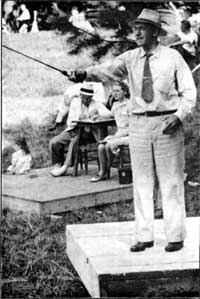
 | ||||||||||
| Intro | Author | Subject | Volume | Volume/Title | NPS | |||||
|
Volume IV - No. 6 |
June, 1940 | |||||||||||||
Clyde Mitchell, a veteran trap-shooter, once said: "I keep in condition by fly-fishing. The fact is, fly casting with its demand of delicate precision and timing, and the light, smooth action of hand and wrist and arm, is the best rehearsal I have ever found for the trap shooter." Last year the National Association of Scientific Angling Clubs officially recognized the sport of "SKISH," formerly called "FISHO". It has been played with much enthusiasm in all 48 states. The advantage of the sport is that it can be played on water or land, indoors or out-of-doors, and during all seasons of the year. The only equipment needed for the game is ten target rings 30 inches in diameter, painted a variety of colors. (A bicycle tire, which measures 28", is satisfactory.) The targets are scattered at random and anchored at unknown distances in the water, varying from 40 to 80 feet from the casting platform. When "skish" is used in a tournament, it is advisable to conform to the rules of the National Association of Scientific Angling Clubs.1 Casting clubs organized at state parks stimulate interest in this activity. Success of the tournament depends largely upon a good local sponsor, such as county fish and game associations, civic clubs, newspapers and other organizations of this type which will promote the activity. After interest is stimulated throughout the surrounding counties, a club can be formed by making the entrants charter members. Casting has been one of the principal activities of the programs being promoted in the state parks of South Carolina, by R. A. Walker, director. Two highly successful tournaments, the first on August 5, 1938, the second on August 6, 1939, have been held at Paris Mountain State Park, Greenville (where the accompanying photographs were made), under the immediate supervision of Covington McMillan, one of the state park recreational directors. The schedule of events was:

Standard equipment was used and scoring was based on the 5-3-2-1 system. Bait casting for distance, where possible, should be over land but that was not possible at Paris Mountain because of rough terrain. The distance casting was conducted from a platform from which two 200-foot ropes radiated so that they were sixty feet apart at the far end. Suitable markers were attached to the ropes at regular intervals as an aid to the judges scoring the event. To speed up the tournament, eliminate waiting on the part of participants, and to keep spectators interested, it was found to be important to provide a separate platform for bait casting for accuracy and still a third platform for fly casting. Mr. McMillan recommends that all platforms be 18 inches above the water, that light colored flies be used and that the platforms and targets be arranged so that the casters face north or south to avoid reflections. The 1939 casting tournament at Paris Mountain drew 28 entries and 54 event entries and had about 400 spectators. A local newspaper, The Greenville News, sponsored the event and donated a cup to the high point winner in 1938 and 1939. (1) Information can be obtained from Edmond F. Sutter, 1853 West Madison St., Chicago, Illinois. SHENANDOAH VOTED VIRGINIA'S LEADING ATTRACTION A general survey conducted by the Virginia Conservation Commission, which assembled the opinions of 236 travel counsellors who direct tourist and travel bureaus in 38 states and Canada, has placed Shenandoah National Park and its famous Skyline Drive at the top of the list of attractions that draw visitors to the Commonwealth. The Shenandoah, which for several seasons has led all other parks of the national system in the annual total of visitors, was found to be most popular with travelers from the North, those from the South coming next, and those from the West third. An analysis of the results of the survey revealed that Westerners have a preference for places of historical interest. | ||||||||||||||
| <<< Previous | > Contents < | Next >>> | ||
|
http://www.cr.nps.gov/history/online_books/regional_review/vol4-6c.htm Date: 04-Jul-2002 | ||||